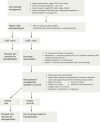Donor selection in heart transplantation
- PMID: 25132976
- PMCID: PMC4133543
- DOI: 10.3978/j.issn.2072-1439.2014.03.23
Donor selection in heart transplantation
Abstract
There is increased scrutiny on the quality in health care with particular emphasis on institutional heart transplant survival outcomes. An important aspect of successful transplantation is appropriate donor selection. We review the current guidelines as well as areas of controversy in the selection of appropriate hearts as donor organs to ensure optimal outcomes. This decision is paramount to the success of a transplant program as well as recipient survival and graft function post-transplant.
Keywords: Heart transplant; donor selection.
Figures


Similar articles
-
Patients and their family members prioritize post-transplant survival over waitlist survival when considering donor hearts for transplantation.Pediatr Transplant. 2020 Mar;24(2):e13589. doi: 10.1111/petr.13589. Epub 2019 Sep 27. Pediatr Transplant. 2020. PMID: 31562687
-
Evaluation of Case Volumes of a Heart Transplant Program and Short-term Outcomes After Changes in the United Network for Organ Sharing Donor Heart Allocation System.JAMA Netw Open. 2020 Sep 1;3(9):e2017513. doi: 10.1001/jamanetworkopen.2020.17513. JAMA Netw Open. 2020. PMID: 32945877 Free PMC article.
-
Three-year survival rates for all consecutive heart-only and lung-only transplants performed in Eurotransplant, 1997-1999.Clin Transpl. 2003:89-100. Clin Transpl. 2003. PMID: 15387100
-
Candidate evaluation and selection for heart transplantation.Curr Opin Cardiol. 1995 Mar;10(2):159-68. doi: 10.1097/00001573-199503000-00011. Curr Opin Cardiol. 1995. PMID: 7787283 Review.
-
Donor management and selection for heart transplantation.Semin Thorac Cardiovasc Surg. 2004 Winter;16(4):364-9. doi: 10.1053/j.semtcvs.2004.09.003. Semin Thorac Cardiovasc Surg. 2004. PMID: 15635542 Review.
Cited by
-
Strategies for Expanding Donors Pool in Heart Transplantation.Rev Cardiovasc Med. 2022 Aug 15;23(8):285. doi: 10.31083/j.rcm2308285. eCollection 2022 Aug. Rev Cardiovasc Med. 2022. PMID: 39076623 Free PMC article. Review.
-
Novel Imaging Technologies for Accurate Assessment of Cardiac Allograft Performance.Curr Transplant Rep. 2023 Sep;10(3):100-109. doi: 10.1007/s40472-023-00400-w. Epub 2023 Jul 17. Curr Transplant Rep. 2023. PMID: 39015560 Free PMC article.
-
Ex vivo lung perfusion and the Organ Care System: a review.Clin Transplant Res. 2024 Mar 31;38(1):23-36. doi: 10.4285/ctr.23.0057. Clin Transplant Res. 2024. PMID: 38725180 Free PMC article. Review.
-
Donor Heart Preservation: Current Knowledge and the New Era of Machine Perfusion.Int J Mol Sci. 2023 Nov 24;24(23):16693. doi: 10.3390/ijms242316693. Int J Mol Sci. 2023. PMID: 38069017 Free PMC article. Review.
-
Zebrafish as a high throughput model for organ preservation and transplantation research.FASEB J. 2023 Oct;37(10):e23187. doi: 10.1096/fj.202300076R. FASEB J. 2023. PMID: 37718489 Free PMC article.
References
-
- John R.Donor management and selection for heart transplantation. Semin Thorac Cardiovasc Surg 2004;16:364-9 - PubMed
-
- Griepp RB, Stinson EB, Clark DA, et al. The cardiac donor. Surg Gynecol Obstet 1971;133:792-8 - PubMed
-
- Cannata A, Botta L, Colombo T, et al. Does the cardioplegic solution have an effect on early outcomes following heart transplantation? Eur J Cardiothorac Surg 2012;41:e48-52; discussion e52-3. - PubMed
-
- Khush KK, Menza RL, Babcock WD, et al. Donor cardiac troponin I levels do not predict recipient survival after cardiac transplantation. J Heart Lung Transplant 2007;26:1048-53 - PubMed
Publication types
LinkOut - more resources
Full Text Sources

